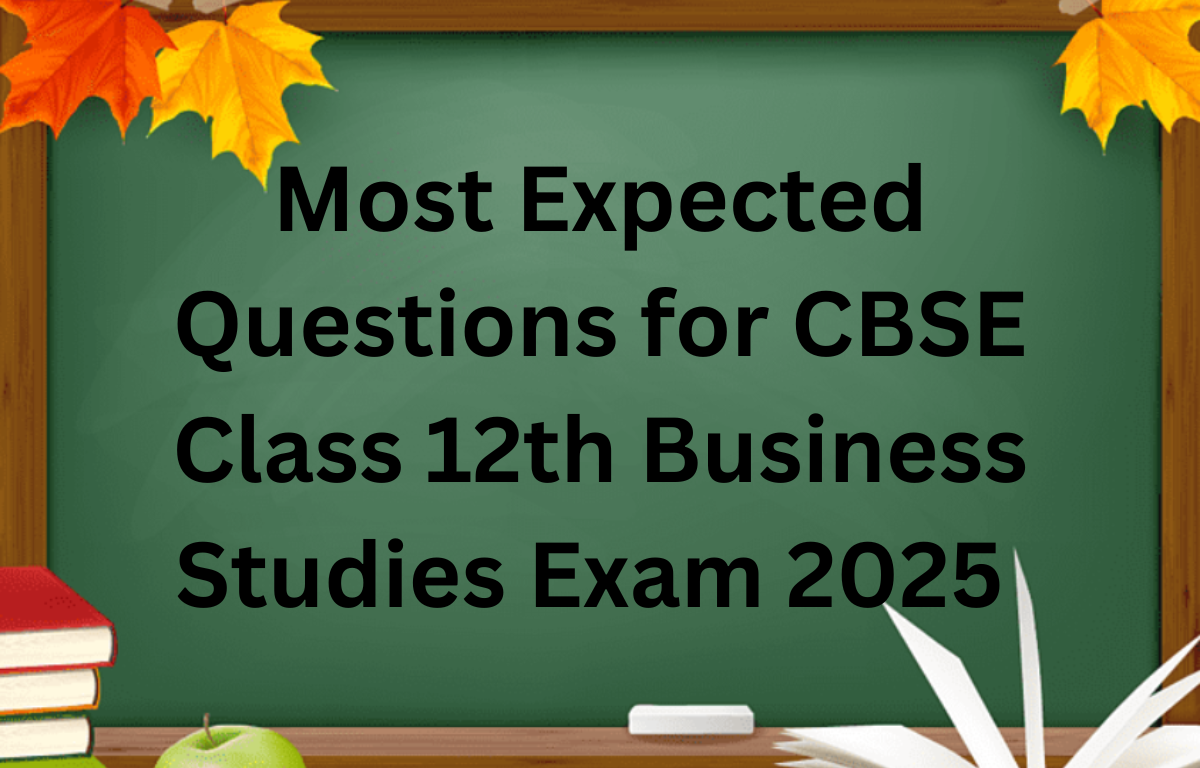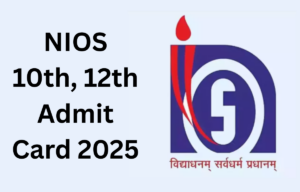Table of Contents
Are you appearing for the upcoming CBSE Class 12th Business Studies Exam 2025, and looking for the most important questions? We have got you covered! All the students appearing for the upcoming Business studies board exam must have already completed their preparation, so we have provided a few CBSE Class 12th Business Studies Most Expected Questions that will help them in their quick revision. These questions are carefully selected from different chapters, based on previous years’ papers and sample papers. Students are advised to check out this list of Most Expected 2, 3, 4, 5 Marks and case study-based Questions for CBSE Class 12 Business Studies 2025 in the article below and make their revision sessions more effective.
CBSE Class 12th Business Studies Most Expected Questions
Case study questions in the CBSE Board Exams 2025 test how well students understand business ideas and their real-world use. Students are advised to focus on important topics like hiring employees, making financial choices, marketing strategies, business surroundings, and government rules. These case-based questions require clear thinking and problem-solving skills. Preparing for such questions will help in understanding key concepts better.
Case Study-Based Questions for CBSE Board Exam 2025
Q1: A company was manufacturing ‘LED bulbs’ that were in great demand. However, the company failed to meet its target of producing 300 bulbs per day due to electricity failure and a shortage of workers. Upon analysis, it was found that the workers were not at fault. The company decided to install a generator to solve the electricity problem and hire more workers to address the labour shortage.
(a) What steps should be taken by the company to fulfil its target, related to the staffing function?
(b) State the benefits of these actions to ‘Moga Industries Ltd.’
Hints for Answer:
(a) Staffing Function Steps:
1. Workforce Planning – Assessing labour needs.
2. Recruitment & Selection – Hiring additional workers.
3. Placement and Orientation – Placement is the process of assigning a job to a selected candidate, while orientation is the process of introducing a new employee to the company and its employees.
4. Training and Development – Enhancing worker skills for efficiency.
(b) Benefits to Moga Industries Ltd.:
1. Increased Productivity – More workers help achieve the daily target.
2. Improved Operational Stability – A generator ensures smooth production.
3. Better Profitability – Higher output leads to more revenue.
Q2: ‘Konark Ltd.’ is an electronic goods manufacturing company in Madhya Pradesh. It earns low revenue compared to ‘Nova Ltd.’, a competitor based in Mumbai. Both companies are affected by local investors, customers, competitors, and suppliers. They are also indirectly influenced by economic factors, social trends, and technological advancements.
(a) Identify and state the feature of the concept discussed in the above paragraph.
(b) Also, state any four points of importance of this concept.
Hints for Answer:
(a) Identified Concept: Business Environment
Feature Highlighted: Specific & Dynamic Nature – Business environments vary across locations due to regional customer preferences, investment patterns, and market trends.
(b) Importance of Business Environment:
1. Identifying Business Opportunities – Helps in tapping new markets.
2. Early Warning Signals – Helps in risk management.
3. Competitive Advantage – Adapting to trends ensures market leadership.
4. Improved Performance – Helps businesses align strategies with external changes.
Q3: ‘Metlapp Networks and Technologies Ltd.’ is a technology leader in the United States. It invented the first smartwatch (W-7) that monitors health parameters. Seeing India’s economic reforms, the company decided to expand to India due to simplified export procedures and reduced trade restrictions. Soon, Metlapp became a market leader, and its success attracted new competitors, leading to price reduction and consumer benefits.
(a) Identify and explain the two major concepts related to government policy discussed in the case.
(b) Explain briefly any three impacts of these concepts on Indian business and industry.
Hints for Answer:
(a) Identified Concepts:
1. Liberalization – Removal of trade restrictions for market expansion.
2. Globalization – International businesses expanding in India.
(b) Three Impacts on Indian Business & Industry:
1. Increased Competition – New businesses entering the market.
2. Technological Advancements – Better products for consumers.
3. Better Customer Choices – Competitive pricing benefits consumers.
Q4: ‘Viyo Ltd.’ is a textile manufacturing company with a ₹60 lakh share capital. Its Earnings Per Share (EPS) was ₹0.50 last year. To diversify, the company needs ₹40 lakh and plans to raise it by issuing 10% Debentures. With a 30% tax rate, its expected Earnings Before Interest and Tax (EBIT) is ₹8 lakh after raising funds.
(i) Is it justified to raise funds by issuing debentures? Give a reason in support of your answer.
(ii) Discuss the impact of issuing debentures on the company’s risk.
(iii) Explain how the ‘cost of debt’ and ‘cost of equity’ influence the capital structure.
Hints for Answer:
(i) Justification for Debenture Issuance:
Yes, it is justified because interest on debentures is tax-deductible, lowering the actual cost of borrowing.
(ii) Impact on Company’s Risk:
- Financial Risk Increases – The company must pay interest regularly.
- Shareholder Risk Rises – If profits fall, shareholders’ dividends may be affected.
(iii) Impact on Capital Structure:
- Cost of Debt – Lower than equity due to tax benefits.
- Cost of Equity – Higher risk means investors demand higher returns.
Q5: ‘Sweets and More’ is one of India’s most popular snack brands. It offers traditional & western snacks in different sizes and packaging, and prices products affordably. Its outlets are in malls, airports, railway stations, and it also sells through retail chains. The brand promotes itself via advertising, sales promotion, and personal selling while focusing on long-term customer relationships.
(a) Identify and explain the elements of the marketing mix discussed in the above case.
(b) Identify any two values which ‘Sweets and More’ wants to communicate to society.
Hints for Answer:
(a) Identified Elements of Marketing Mix:
1. Product – A variety of snacks and sweets are offered.
2. Price – Reasonable pricing strategy.
3. Place – Available at convenient locations and retail chains.
4. Promotion – Uses multiple marketing tools like advertising and personal selling.
(b) Values Communicated by ‘Sweets and More’:
1. Customer Satisfaction – Affordable, quality products.
2. Convenience & Accessibility – Easily available across different locations.
Most Expected 2 to 3 Marks Questions for CBSE 12th Business Studies Exam 2025
Q1: State any three money market instruments.
Answer: Treasury Bills, Commercial Paper, Certificates of Deposit.
Q2: State any three points of importance of the ‘Directing’ function of management.
Answer: 1. Initiates Action – Directing starts the execution of plans.
2. Integrates Employee Efforts – Aligns individuals toward common goals.
3. Provides Guidance – Ensures clarity in tasks and responsibilities.
Q3: Explain any three points of importance of ‘Planning’.
Answer: 1. Provides Direction – Helps businesses focus on objectives.
2. Reduces Uncertainty – Minimizes risks by anticipating future challenges.
3. Promotes Innovation – Encourages creative problem-solving.
Q4: State any three limitations of the Divisional Structure of an organisation.
Answer: 1. Conflicts Between Divisions – Departments may compete for resources.
2. Duplication of Resources – Repetition of functions increases costs.
3. Difficult Coordination – Managing multiple divisions can be challenging.
Q5: Enumerate any three rights of a consumer under the Consumer Protection Act, 2019.
Answer: 1. Right to Safety – Protection from hazardous goods/services.
2. Right to be Informed – Complete product/service details.
3. Right to Choose – Freedom to select from a variety of goods.
Q6: Explain the first two steps in the process of controlling.
Answer: 1. Establishing Standards – Setting performance benchmarks.
2. Measuring Actual Performance – Comparing results with standards.
Q7: Give the meaning of formal and informal communication.
Answer: Formal Communication – Follows the official hierarchy within an organization.
Informal Communication – Happens through social interactions, e.g., grapevine communication.
Q8: Give the meaning of Financial Management and state its main objective.
Answer: Financial Management involves planning, organizing, and controlling financial activities.
Main Objective: Maximize shareholders’ wealth.
Q9: What is meant by Delegation’?
Answer: Delegation refers to assigning responsibility from a manager to a subordinate for specific tasks.
Q10: Explain briefly transfer and promotion as important sources of internal recruitment.
Answer: Transfer – Moving an employee to a different department or role at the same level.
Promotion – Elevating an employee to a higher role with greater responsibilities.
CBSE Business Studies 2025: 4 to 5 Marks Most Expected Questions
Q1: Explain any four points of importance of principles of management.
Answer: 1. Provides Managers with Useful Insights – Improves decision-making.
2. Optimum Utilization of Resources – Enhances efficiency and reduces wastage.
3. Scientific Decisions – Encourages systematic and logical decision-making.
4. Flexible and Adaptable – Can be modified according to changes in the business environment.
Q2: Explain any five points of significance of Principles of Management.
Answer: 1. Scientific Approach to Management – Moves beyond guesswork.
2. Helps in Meeting Changing Environments – Adapts to external shifts.
3. Encourages Research and Development – Promotes innovation.
4. Fulfilling Social Responsibilities – Ensures ethical business practices.
5. Enhances Managerial Efficiency – Improves coordination and performance.
Q3: State any five regulatory functions of the Securities and Exchange Board of India (SEBI).
Answer: 1. Registration of Brokers and Sub-Brokers – Ensures proper market functioning.
2. Regulation of Stock Exchanges – Prevents unfair trade practices.
3. Levying Fees and Penalties – Imposes fines for non-compliance.
4. Regulating Insider Trading – Prevents misuse of confidential information.
5. Protecting Investor Rights – Ensures transparency and fair dealing.
Q4: Explain the following rights of a consumer:
Answer: Right to Choose – Consumers must have access to multiple options.
Right to Safety – Protection from unsafe products or services.
Q5: What is meant by Investment Decision? State how Long-Term Investment Decision is significant.
Answer: Investment Decision refers to choosing where to allocate financial resources.
Significance of Long-Term Investment Decision:
1. Affects future business growth.
2. Helps in capital investment decisions.
3. Determines long-term financial health.
4. Requires careful risk assessment.
5. Involves strategic allocation of funds.
Q6: State any five points which highlight the importance of delegation of authority.
Answer: 1. Reduces Workload of Managers – Allows managers to focus on priorities.
2. Leads to Effective Management – Improves overall efficiency.
3. Helps in Employee Development – Encourages skill-building.
4. Facilitates Growth – Expands business operations.
5. Enhances Employee Motivation – Employees feel empowered.
Q7: Explain any five characteristics of coordination.
Answer: 1. Integrates Group Efforts – Aligns different departments.
2. Ensures Unity of Action – Prevents conflicts.
3. Continuous Process – Needed at all times.
4. Deliberate Effort – Requires managerial attention.
5. Increases Efficiency – Reduces redundant efforts.
Q8: How does understanding the Business Environment help management?
Answer: Identification of Threats & Early Warning Signals
- Helps in recognizing risks such as market competition.
- Allows proactive decision-making.
Improving Performance
- Helps businesses stay ahead of market trends.
- Encourages strategic planning for growth.
Q9: Explain the following techniques of scientific management:
Answer: Motion Study – Identifies unnecessary movements to increase efficiency.
Time Study – Determines the standard time required for task completion.
Q10: State any four advantages of external sources of recruitment.
Answr: 1. Wider Choice of Candidates – Increases talent pool.
2. Brings Fresh Talent and Ideas – Encourages innovation.
3. Reduces Internal Conflicts – Avoids bias in promotions.
4. Enhances Business Competitiveness – Brings in specialized expertise.
Most Expected Questions for CBSE Class 12th Business Studies Exam 2025 PDF Download
All the students appearing for the upcoming CBSE Class 12th Business Studies Exam 2025 can check the direct link to download the most expected case-study-based and 2, 3, 4, 5 marks questions PDF in the table mentioned below and start their last-minute revision.
| Most Expected Questions for CBSE Class 12th Business Studies Exam 2025 PDF Download |
| CBSE Class 12th Business Studies Most Expected Case Base Questions |
| Most Expected 2, 3, 4, and 5 marks Question for CBSE Class 12th Business Studies |


 NEET 2025 Admit Card Release Date Out, C...
NEET 2025 Admit Card Release Date Out, C...
 CBSE Result 2025: Will CBSE Release the ...
CBSE Result 2025: Will CBSE Release the ...
 NIOS 10th, 12th Admit Card 2025 released...
NIOS 10th, 12th Admit Card 2025 released...